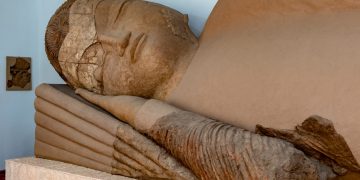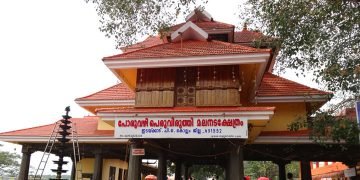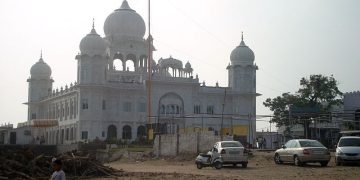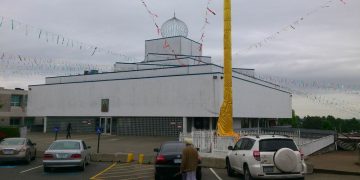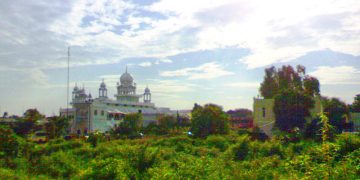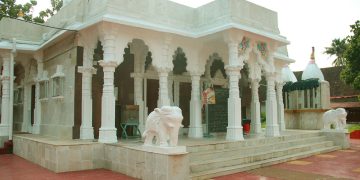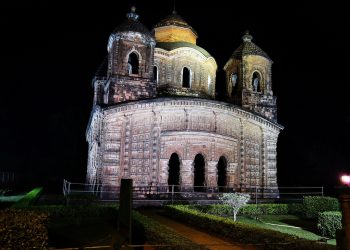Simhadri or Simhachalam is a Hindu temple located in Visakhapatnam city suburb of Simhachalam in Andhra Pradesh, India. It is dedicated to Lord Narasimha, an incarnation of Lord Vishnu.The central shrine was built in Kalinga architectural style.
Shrine’s History
Templehas Sri Varahalakshmi Narasimha Swamy as the presiding deity. The deity at Simhachalam, the lion-man incarnation of Lord Mahavishnu is usually covered with sandalwood paste. The original shape of the deity in the tribhanga posture has two hands with the head of a lion on a human torso. An inscription dated as far back as 1098 AD of the Chola King Kuloththunga provides some clue as to its antiquity. Another inscription shows a Queen of the Eastern Ganga of Kalinga covering the image with gold while a third inscription says the eastern Ganga King of Orissa, Narasimha Deva, built the main/central shrine in 1267 A.D. With more than 252 inscriptions in Oriya and Telugu describing the antecedents of the temple, it is a historically important monument.
Sri Krishna Deva Raya after defeating the Gajapati ruler of Orissa Gajapati Prataparudra Dev visited the shrine twice in 1516 AD and 1519 AD and offered numerous villages for maintenance of bhogam along with valuable jewellery of which an emerald necklace is still in the temple. For the last three centuries the royal family of Vizianagaram, “The Pusapati Gajapathi’s” have been the temple’s trustees. Giripradhikshana around the hill range from Hanumantha vaka/MVP colony to Simhachalam is done by pilgrims during the auspicious days. Crowds of elderly people/youth/children are observed walking the 40 km stretch overnight. They visit the temple after the long journey and give their offerings to the deity.
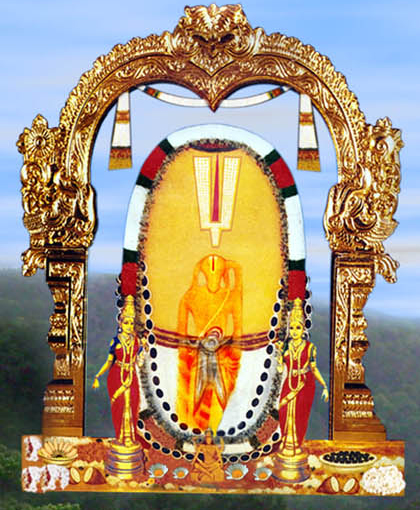
Legends Associated with This Shrine
As per legend, Jaya and Vijaya, the two gatekeepers of Lord Vishnu, had disallowed Sanaka, Sanandana and Sanathkumara to get the darshan of Mahavishnu and therefore were cursed by them. As a result of the curse, Jaya and Vijaya were born as demons Hiranyakasipu and Hiranyaksha respectively to Sage Kashyapa. Angered by the atrocities and destruction propagated by Hiranyaksha, Lord Vishnu in the avatar of Varaha killed him. Meanwhile, Hiranyakapisu wanted to avenge the death of his brother and therefore to attain immortality, he performed severe penance to Lord Brahma. One of the servants of the Lord, Sumukha, was born to Hiranyakapisu as Prahalada, who became an ardent devotee of Lord Vishnu from his childhood.
Angered by his devotion, Hiranyakapisu wanted to kill Sumukha by throwing him, from the top of a mountain. However, Lord Vishnu rescued Prahlada by jumping over from the Garuda. The very place from which he saved Prahlada is the location of the temple and after jumping from the Garuda the feet of Lord Vishnu sunk in the ground. Therefore, the feet of the Lord are hidden beneath the idol. Lord Vishnu, in the Narasimha avatar, killed Hiranyakapisu. Prahalada ardently prayed to Lord Vishnu, to appear in both the forms of Varaha and Narasimha . Thereafter, Lord Vishnu appeared in the form of a deity, in both his Narasimha and Varaha avatars. Prahalada built a temple around the deity, which was later neglected. One day when Purvasa was travelling on an aerial chariot, with his spouse Urvashi, he was drawn towards the ruins of the temple and an Aakashvani directed Purvasa to cover the idol with sandal paste. The Aakashvani also stated that the Lord would be visible in his Nijaswarupa form only for twelve hours in a year, on the third day of the month of Vysakha. Purvasa rebuilt and renovated the temple.

Architectural Relevance of This Shrine
The abundance of inscriptions on the walls of the temple makes the Varaha Narasimha Swamy Temple a site of extreme cultural significance. The Varaha Narasimha Swamy Temple also epitomises the Chalukyan and Orissan style of architecture. The donations available to the temple are only second to Tirumala.
Shrine’s Map Location and How to Go There
By Road
The nearest bus stop is Visakhapatnam
By Rail
The nearest railway station is Visakhapatnam.
By Air
The nearest airport is Visakhapatnam.
Shrine Timings
Morning : 7 Am to 11.30 AM
Afternoon: 12.30 Pm to 7PM
Evening: 7.30 to 8.30 PM
Events Celebrated at This Shrine
UGAADHI (TELUGU NEWYEAR) Pandhiri raata utsavam, making Sri Swamy as a bridegroom. NRUSIMHA JAYANTHI Will be Celebrated on this day Swamy vari Jayantotsavam (Vaisakha Sukla Chathurdasi). The Narasimha Jayanthi festival, which occurs on the Fourteenth day of the first half of month of ‘Vaisakha’ is celebrated as Birthday of the Lord.
RADHOTSHAVAM Held before Swamy going to marriage.
KALYANOTHSAVAM Sri Swamy vari Vaarshika Thirukalyana Mahothsavam.
CHANDANOTHSAVAM It is also called Nijaroopa Darshanam, Vaisakha Sudda Tadiya Usually comes in the month of April/May. On this day more than one lakh people will have darshan of lord Narasimha from early morning. Only on this day, Swamy gives darshan without chandanam layer on his body i.e., Nijaroopa Darshanam every year. VAISAKHA POURNAMI 2nd phase Chandana Samarpana. It is one of the holy days in temple festivals.
JYESTA POURNAMI 3rd phase Chandana Samarpana at early Morning. TEPPOTSAVAM Will be celebrated on Pushya Bahula Amavasya. On this day Utsava idols are taken to Varaha Pushkarini from the temple in a palanquin. The procession that began on the Simhachalam hill at 3 p.m. reached the foothill around 4.30 p.m. People gathered in good numbers alongside the streets to have a darshan of the Lord.
KANUMA The ‘Utsava Moorti’ of the presiding deity, Lord Sri Varaha Lakshminarasimha Swamy, was brought downhill to the temple garden for darshan. The idols of the deity were then taken to Sri Pydithalli Ammavari temple. A fair was organised by the temple administration near the temple lake. A scene depicting an episode from Gajendra Moksha from Srimad Bhagavatam was also recreated by priests. VYKUNTA EKADASI Will be celebrated on Dhanusudda Ekadasi, on this day the Lord Varaha Narasimha Swamy attracted to pilgrims on vykunta dwaram.
GIRI PRADHAKSHINA It comes on Aashada Pournami generally at June/July month. On this day the people walk around the Simhachalam hill which was in distance 34 km. On the full-moon day of the month of ‘Aashada’, June, the devotees of the Lord, hailing mainly from the countryside, observe a fast on this day and go around the hill over a distance of about twenty miles. They eat their dinner after completing the Pradakshina and after having ‘Darshan’ of the Lord. Those, who cannot undertake this, satisfy themselves by making 108 rounds in the temple itself.



